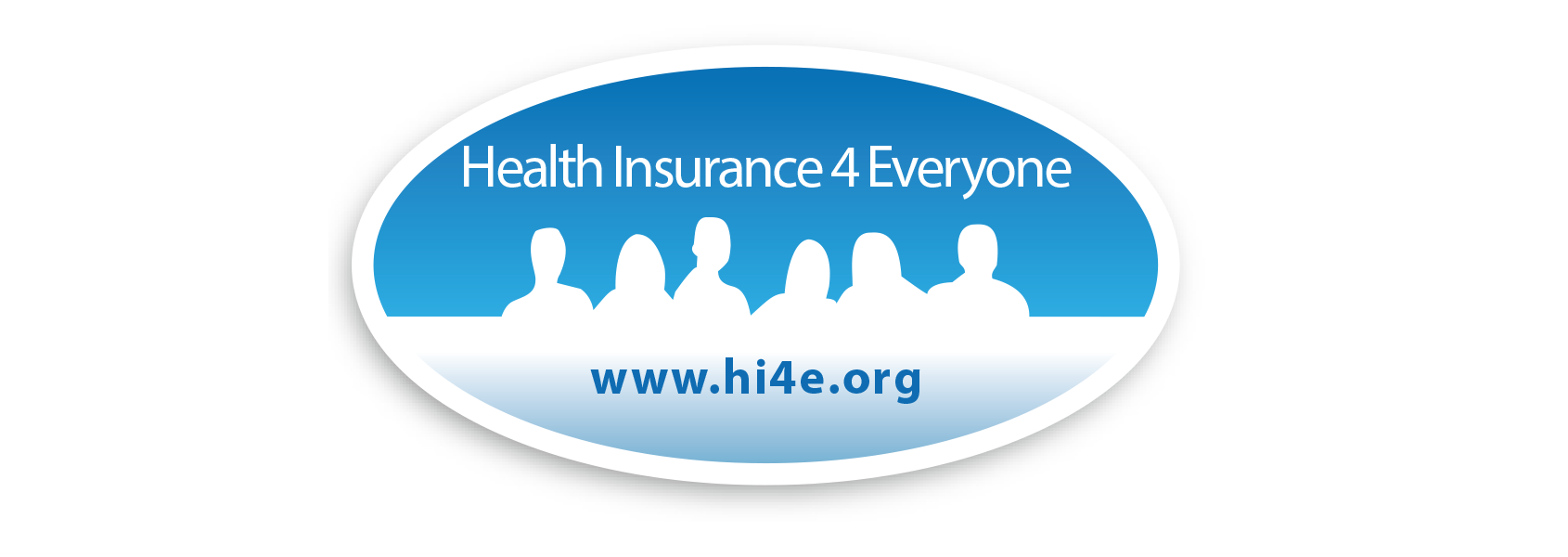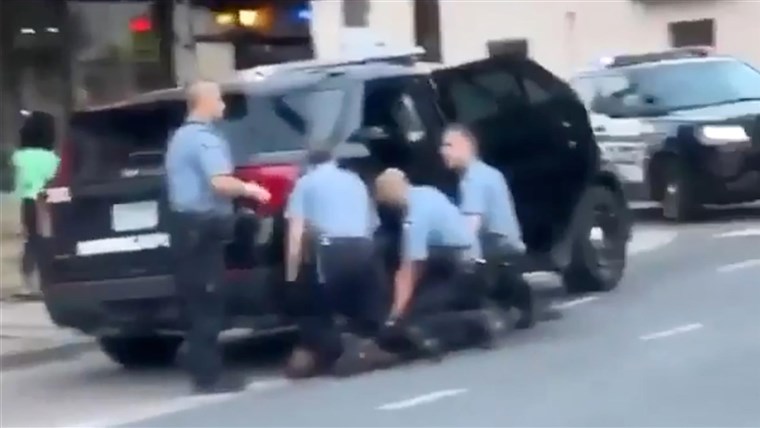
Protests erupted in Minneapolis, Minnesota after video footage of the death of George Floyd, 46, went viral. Floyd died after being arrested by police outside a shop on May 25th on a report he used a fake $20 bill to buy a pack of cigarettes from Cup Foods, a grocery store. The video shows now fired police officer, Derek Chauvin, kneeling on Mr Floyd’s neck while he was laying on his stomach in the street with his hands cuffed behind his back. Floyd can be heard repeatedly saying “Please, I can’t breathe, please, please officer don’t kill me” for the 8 minutes and 46 seconds that Officer Chauvin held him pinned to the ground with his knee on the back of Floyd’s neck.
In the video of the incident, a bystander tells the police: “You got him down. Let him breathe.” After Floyd says, “I’m about to die,” Chauvin tells Floyd to relax. The police ask Floyd: “What do you want?” Floyd repeats: “I can’t breathe.” Floyd continues: “Please, the knee in my neck, I can’t breathe.” The policemen taunt Floyd to “get up and get in the car,” to which Floyd replies: “I will… I can’t move.” Floyd also cries out: “Mama!” He then says “My stomach hurts, my neck hurts, everything hurts,” and requests water. The police do not audibly respond to Floyd. Floyd begs: “Don’t kill me.” A bystander points out that Floyd is bleeding from the nose. Another bystander tells the police that Floyd is “not even resisting arrest right now.”
The day after Mr. Floyd’s death, the Police Department fired all four of the officers involved and the Hennepin County attorney, Mike Freeman, announced murder and manslaughter charges against Derek Chauvin, the officer who can be seen most clearly in witness videos pinning Mr. Floyd to the ground. Chauvin kept his knee on Floyd’s neck for eight minutes and 46 seconds, according to the criminal complaint against him. Video show that Chauvin did not remove his knee even after Mr. Floyd lost consciousness and for a full minute after paramedics arrived at the scene. Floyd’s last words have been compared to those of Eric Garner who uttered the words “I can’t breathe” eight times before he died while being placed in a chokehold by Officer Daniel Pantaleo in July 2014.
Derek Chauvin had 18 complaints over his 19 year career as a police officer with 2 resulting in disciplinary actions. Chauvin has been the subject of several internal complaints as well. George Floyd and fired police officer Derek Chauvin knew each other before the fatal encounter. Chauvin worked outside security at a bar for 17 years while Floyd worked security inside the bar. Floyd grew up in Houston Texas and 13 years ago in 2007 he was charged with armed robbery in a home invasion in Houston In 2009 he was sentenced to five years in prison as part of a plea deal, according to court documents. In 2014 he moved to Minneapolis looking for work and a new start. Videos he posted on social media while under stay at home orders show him denouncing violence and encouraging his community to find another way.
While the protests started in Minnesota, they quickly spread across the globe. Demonstrators gathered in London, France, Germany, Denmark, Italy, Syria, Brazil, Ireland, Poland, Mexico, Canada and New Zealand, among other places, to protest against police brutality in solidarity with the US crowds. Demonstrators have gathered in the thousands in many major cities worldwide. Many protestors remain peaceful but their message has been marred by the violence, looting and vandalism taking place in cities across the US.
Read more

A Missouri resident has tested positive for COVID-19 after going to the Lake of the Ozarks over the Memorial day weekend, health officials said. The Camden County Health Department said one person tested positive for the virus from Boone County. Health officials said the person did visit Backwater Jack’s, which is the outdoor pool and bar, where a viral video of people not social distancing was taken on Memorial Day weekend. Authorities say the person developed the illness on Sunday and was likely incubating illness and possibly infectious at the time of the visit.
Health officials provided the following timeline for contact tracing:
Saturday, May 23- Backwater Jacks – 1pm to 5pm, Shady Gators and Lazy Gators Pool — 5:40pm to 9pm,
Backwater Jacks — 9:40pm to 10pm, Sunday, May 24 – Buffalo Wild Wings – 1pm to 2pm, Shady Gators — 2:30pm until about 6:30pm or 7pm, Taxi from Shady Gators to private residence about 7pm. They encourage anyone who was at these locations during these times to get tested for Covid 19.
Photos and videos of partygoers crowded into the swim up bar-Backwater Jacks circulated social media over the holiday weekend. Backwater Jack’s Bar and Grill in Lake of the Ozarks is a popular vacation spot in the Midwest that regularly draws summer crowds. It was no different last weekend, even given the pandemic, and people are blasting the restaurant and attendees for ignoring social distancing advice. It’s clear from posts on social media that even if the venue was operating at reduced capacity, it was too crowded to maintain 6 feet between attendees.
Visitors and lake area residents told news outlets they were concerned with the lack of social distancing and safety that lead to a positive coronavirus case because they know the area attracts people from out of state also. “Everyone saw it coming so it’s kind of irony. Everyone’s like oh it’s fine we won’t do anything. But, there’s 200 people in a little pool. So I saw it coming. That’s why I tried to protect myself and make sure I keep others safe as well.” One Lake area resident said.
A visitor to the Lake Area said “They were taking a chance and I’m concerned about what the outcome will be in another week or two. With the one case showing up. Everyone that was exposed to that person is exposing a lot of other people. So it’s a bit concerning.”
The Missouri Department of Health and Senior Services said Monday 773 deaths have been attributed to COVID-19 in the state and there are over 13,000 confirmed cases since the outbreak started. The Kansas Department of Health and Environment said Monday the state has almost 10,000 confirmed cases of COVID-19 and there have been 217 deaths since the outbreak started. The US death toll over 100,000.
Read more

Physicians caution that amid a desire to put an end to the Covid-19 pandemic, developers of drugs and vaccines have become overly enthusiastic about the chances their products will work. Several vaccine developers have issued statements looking into the future — setting possible timetables for study completion and vaccine manufacturing.
Biotech company Moderna said early trials of their coronavirus vaccine show promising results as volunteers developed antibodies against the virus. Eight people took part in the study. The company, which is developing the vaccine with the National Institutes of Health, says it will move on to larger-scale trials and that a vaccine could be made available as soon as January. Moderna is collaborating on its vaccine development with the National Institute of Allergy and Infectious Diseases. Dr. Anthony Fauci, the director of NIAID, said while Moderna’s numbers were limited, “it was good news” and he was “cautiously optimistic” about the vaccine.
According to the World Health Organization (WHO), there are currently over 100 vaccine efforts underway around the world. There are 10 vaccines in human clinical trials worldwide. There are four teams in the United States: Moderna, Pfizer, Inovio and Novavax. Five Chinese companies have vaccines in human trials. University of Oxford is the only team in Europe currently running trials. Inovio and Moderna have said they expect their large-scale clinical trials, known as Phase 3 trials, to last around six months. Pfizer hasn’t given a timetable for its Phase 3 trial. Worldwide, there are 114 more candidates in pre-clinical trial stages.
One big stumbling block for any vaccine trial is that Covid-19 infection rates in many areas of the world are flattening out or declining. The point of Phase 3 is to vaccinate people and then see if they naturally become infected, and with lower rates of circulating virus, the study subjects are less likely to be exposed to the virus in the first place. For a vaccine clinical trial to be successful, there needs to be sufficiently high levels of the virus circulating in the community. If there isn’t enough virus around, it will be impossible to tell if the vaccine protected the study subjects, or if they were just never exposed to the virus.
The global effort to develop a vaccine is just the beginning of this race. It also takes time to ramp up vaccine production and deciding how it will be distributed will be difficult in a world of more than 7 billion people. New drugs and vaccines traditionally go first to the wealthiest countries and that’s the expectation in this case as well. But the exact order could depend on where the vaccine is first developed and what that countries priorities are in distribution. Wealthier countries have been hit hardest by the virus so far. But in many of these nations, COVID-19 cases are leveling off or declining, while they are rising rapidly in the developing world, including countries such as India, Brazil and Peru. Nations and drug companies are likely to face a range of conflicting pressures with the need to provide the vaccine at home and intense scrutiny to share it widely, fairly and cheaply abroad.
Read more
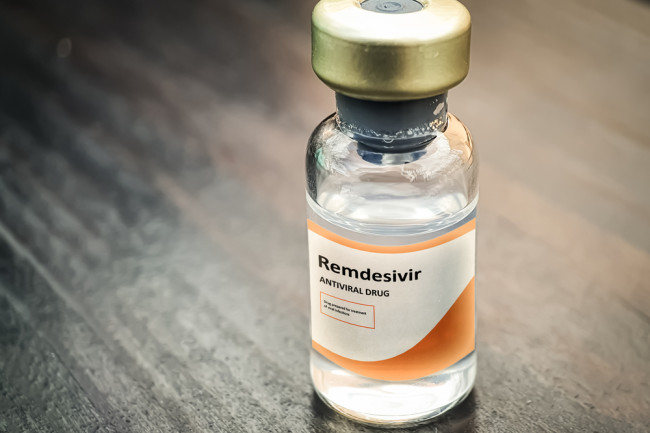
The Food and Drug Administration (FDA) announced the emergency use authorization for the antiviral drug remdesivir, after preliminary results from a federal trial showed the drug could speed recovery in patients infected with the coronavirus. The finding, which has not yet been peer reviewed, came after another study found no benefit for the drug in severely ill patients in China. The new results suggest a moderate improvement in the death rate of patients taking remdesivir, whose hospital stays were shortened, on average, from 15 days to 11.
The issuance of an EUA is different than FDA approval. In determining whether to issue an EUA, the FDA evaluates the available evidence and carefully balances any known or potential risks of any unproven products with any known or potential benefits of making them available during the emergency. Based on evaluation of the emergency use authorization criteria and the scientific evidence available, it was determined that it is reasonable to believe that remdesivir may be effective in treating COVID-19, and that, given there are no adequate, approved, or available alternative treatments, the known and potential benefits to treat this serious or life-threatening virus currently outweigh the known and potential risks of the drug’s use.
The emergency use authorization (EUA) allows for remdesivir to be distributed in the U.S. and administered intravenously by health care providers, as appropriate, to treat suspected or laboratory-confirmed COVID-19 in adults and children hospitalized with severe disease. Severe disease is defined as patients with low blood oxygen levels or needing oxygen therapy or more intensive breathing support such as a mechanical ventilator.
The EUA requires that fact sheets that provide important information about using remdesivir in treating COVID-19 be made available to health care providers and patients, including dosing instructions, potential side effects and drug interactions. The EUA is temporary and will be effective until the declaration that circumstances exist justifying the authorization of the emergency use of drugs and biologics for prevention and treatment of COVID-19 is terminated. It may be revised or revoked if it is determined the EUA no longer meets the statutory criteria for issuance.
Possible side effects of remdesivir include increased levels of liver enzymes, which may be a sign of inflammation or damage to cells in the liver; and infusion-related reactions, which may include low blood pressure, nausea, vomiting, sweating, and shivering.
The top coronavirus task force scientist Dr. Anthony Fauci welcomed news of the first potential treatment for COVID-19. The U.S. government will coordinate the donation and distribution of remdesivir to hospitals in cities most heavily impacted by COVID-19. Given the severity of illness of patients appropriate for remdesivir treatment and the limited availability of drug supply, hospitals with intensive care units and other hospitals that the government deems most in need will receive priority in the distribution of remdesivir.
Read more
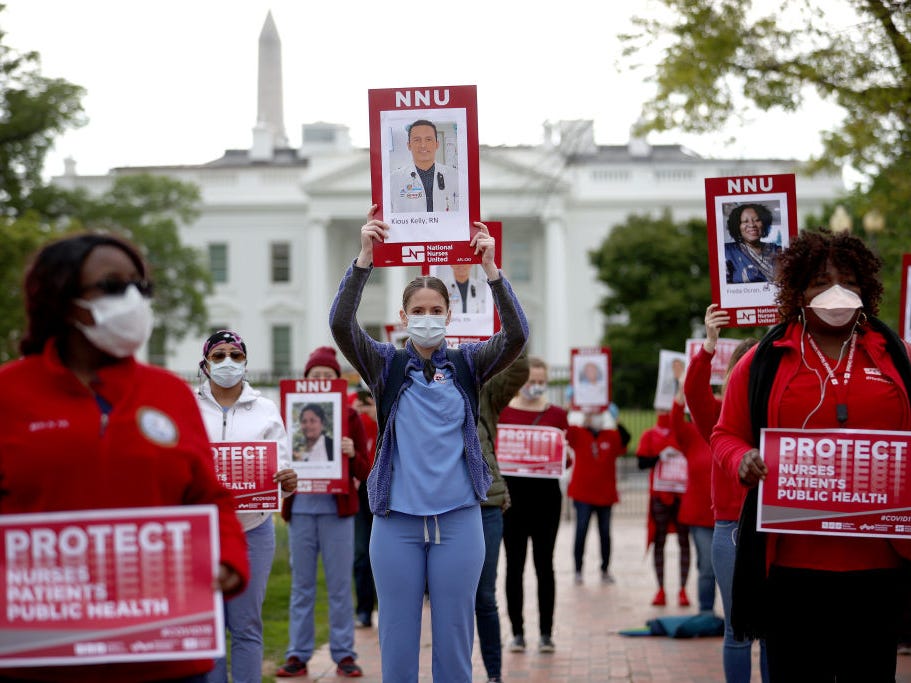
Dozens of nurses held a protest and vigil outside the White House reading the names of 50 healthcare workers who have died after becoming infected by the coronavirus on the job. The protest was organized by National Nurses United, which is demanding the Occupational Safety and Health Administration require adequate personal protective equipment for healthcare workers.
The Centers for Disease Control and Prevention reported 9,200 healthcare workers have tested positive for COVID-19, though the CDC admits the true rate is likely much higher. CDC data shows that 73% of the health workers falling ill are female and their median age is 42. US officials also say they have no comprehensive way to count those who lose their lives trying to save others. A limited CDC infection tally said 27 healthcare worker have died but stressed that the count was drawn from just 16% of the nation’s Covid-19 cases, so the true numbers of healthcare infections and deaths are certainly far higher.
Some states, including Ohio, have reported rates of healthcare worker illness as high as 20% but have not revealed data at the county, city or hospital levels. One health system, Henry Ford in the Detroit area, reported that more than 700 employees tested positive for Covid-19. Yet they have declined to say how many workers died, as in Ohio, to protect patient privacy. Media reports have shown case after case of healthcare workers across the US saying they do not have adequate protective gear to keep from getting sick.
The New York State Nurses Association filed a lawsuit the New York Department of Health and two hospitals Monday for their failure to provide adequate safety measures at the start of the coronavirus crisis. The lawsuits alleges the failures of Gov. Andrew Cuomo’s administration and the two hospitals for not providing sufficient protective equipment, like masks and gowns. NYSNA executive director Pat Kane said that more than 70% of her nurses reported being exposed to the dangerous disease and that most are still untested.
Media outlets revealed last month that at one of the hospitals named in the suit, a shortage of gowns was so dire that nurses battling the coronavirus pandemic at Mount’s Sinai’s Midtown West hospital resorted to wearing trash bags over their uniforms for protection. One of there coworkers, a beloved assistant nursing manager, Kious Kelly, died from the coronavirus. At the time of her death, Mount Sinai insisted there was no shortage of PPE.
Read more
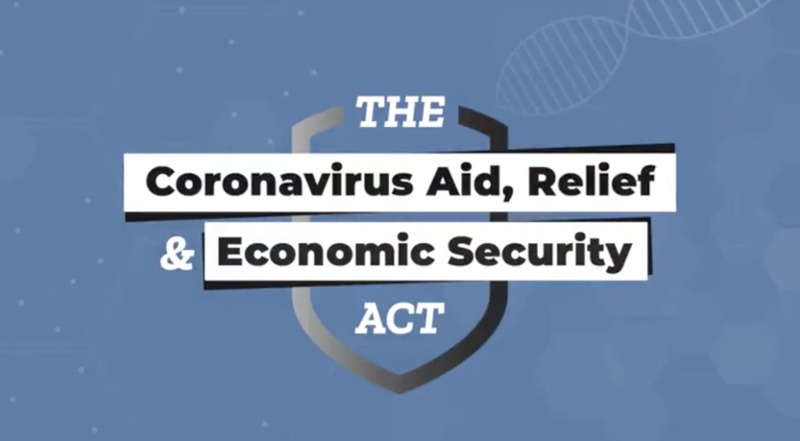
The US Senate overwhelmingly approved $484 billion in new coronavirus aid with most of the money replenishing the Paycheck Protection Program, set up to provide forgivable loans to small businesses. The bill adds another $310 billion to the Paycheck Protection Program, another $75 billion for hospitals, $25 billion for testing and $60 billion for emergency disaster loans and grants.
The bill provides no new stimulus checks for U.S. households, no additional money for food stamps, no limits on fossil fuel bailouts, no funds for election security, no bailout for the U.S. Postal Service and no additional funds for hard-hit state and local governments. Lawmakers were criticized for refusing to take up new assistance to hard-hit U.S. residents — like cash payments and food aid — in the latest relief bill. They were also criticized for not regulating the disbursement of the initial funds which allowed big businesses like corporate chain restaurants getting tens of millions of dollars in loans meant for small businesses.
They contend lawmakers are failing to provide for millions of unemployed people who are unable to pay rent and increasingly at risk of going hungry. Progressive lawmakers are demanding $2,000 monthly payments to all U.S. households and open enrollment in Medicare for uninsured and unemployed people, when lawmakers take up another round of funding, the so-called phase four coronavirus bill.
Senators are in talks for a phase four bill with priorities for that legislation including federal assistance for people having trouble paying rent, according to a Democratic source. Schumer also cited the need for funds for election reform, hazard pay for essential workers, including doctors, nurses and grocery store clerks, and funding for the U.S. Postal Service. Many are skeptical since the virus bailouts have already cost over $2 trillion, pushing our annual deficit this year to close to $4 trillion.
The pandemic continues to batter the U.S. economy as the Labor Department reported another 4.4 million U.S. workers filed for unemployment benefits over the last week, raising new jobless claims over the past five weeks to more than 26 million — a scale that hasn’t been seen since the Great Depression. As of March 13, there were already 7.1 million unemployed Americans, according to the U.S. Bureau of Labor Statistics. When the figures are combined, it would equal more than 33 million unemployed, or a unemployment rate of 20.6%—which would be the highest level since 1934.
Read more

As countries impose lengthy lockdowns to combat the spread of the coronavirus, reported cases of domestic abuse have spiked around the world. In the weeks since populations worldwide have been directed to “stay home” to prevent the virus’s spread, cases of domestic violence have surged — and that’s reported cases. Women who are victimized are now confined to isolated homes with abusive partners whose coercive and physically violent tendencies are enabled and further inflamed by economic stressors. Supportive community ties are severed, while emergency services, shelter systems, and social services are overwhelmed and congenitally underfunded.
Millions of Americans are not safe from violent abuse at home and now the federal, state and local governments are telling everyone to stay home – for their own safety. For some people, going to work may be their only reprieve from emotional abuse and violence. For others, the only place their children are safe from abuse is at school. Now they have been told to stay at home. Few jobs are completely safe from the economic fallout of the coronavirus crisis and stressed abusers have their targets at home.
According to statistics released by the U. N., reports of domestic violence in France rose 30% following the country’s lockdown on March 17; during the first two weeks of lockdowns in Spain, the emergency number for domestic violence received 18% more calls; and help lines in Singapore have received 30% more calls. In the US, law enforcement agencies have seen domestic violence cases rise up to 35% in recent weeks. Keeping in mind, that 50% of domestic abuse cases go unreported.
Advocates fear domestic violence survivors may have trouble getting away from their abusers and are calling the rise an epidemic during a pandemic. They are urging communities around the world to make sure resources are readily available for survivors. Even before the pandemic, an average of 20 people in the United States experienced physical domestic violence every minute. Research shows 1 in 4 adult American women and 1 in 7 adult American men have experienced some type of severe violence – including being hit with something hard, being kicked or beaten, or being burned on purpose – at the hands of an intimate partner.
Advocates are already seeing a pattern of increasing domestic violence around the world, correlating with the timing of social distancing lockdowns. In Seattle, one of the first U.S. cities to have a major outbreak, the police saw a 21% increase in domestic violence reports in March. In Texas, during March the Montgomery County District Attorney saw a 35% increase in domestic violence cases. Police around the country are adapting their domestic violence response plans to prepare for the expected increases and to ensure victims can get help even with restrictions on public movement.
Many organizations that serve survivors of domestic violence may also struggle to stay afloat during the pandemic. Many child-protective organizations are experiencing strain with fewer workers available, so they may be unable to conduct home visits in areas with stay-at-home orders. While such operational changes may lead to inaccurate reporting of child abuse and neglect, many advocates are expecting a surge in cases to continue to rise while they’re resources are still limited during the pandemic. The recent US$2 trillion federal CARES Act included assistance for nonprofits that provide support for domestic violence victims, letting them apply for business loans and help meeting payroll.
Read more

While the US has become the global epicenter for the Covid-19 pandemic, New York State is the US’s epicenter, far leading in confirmed cases and deaths. Over 200,000 of the confirmed cases in the US are in New York and over 10,000 people in the state have died. Almost 110,000 of those cases are concentrated in New York City. About 25% of New York State’s COVID19 deaths are residents of nursing homes and adult care facilities. There are about 96,000 residents at 613 licensed nursing homes in New York State. More than 5,500 residents at 338 nursing homes have tested positive for the coronavirus.
For the first time since the coronavirus crisis struck New York, there were fewer admissions to the intensive care unit on Thursday, April 9th than the day before. It’s one of a number of encouraging signs that the worst may have passed. The governor said that he is “cautiously optimistic” that we are slowing the infection rate. He cited a dramatic decline in hospitalizations and even a negative statistic for the first time in the ICU.
Governor Cuomo said that social distancing policies and compliance by the public greatly flattened the curve after the death toll stabilized but he warned the situation is still dire and New Yorkers would need to maintain strict measures to continue the trend. Gov. Andrew Cuomo: “If we are plateauing, we are plateauing at a very high level, and there’s tremendous stress on the healthcare system. And to say to this healthcare system — which is at maximum capacity today, right? This is a hospital system where we have our foot to the floor and the engine is at red line and you can’t go any faster. And by the way, you can’t stay at red line for any period of time, because the system will blow.”
Cuomo said schools and nonessential businesses will now remain closed and he announced fines for violating social distancing rules would increase from a maximum of $500 to $1,000. As of today, New York State has nearly 5,000 recorded deaths from COVID-19, with over 131,000 confirmed cases and over 16,000 hospitalizations. While the total number of statewide cases of Covid 19 hospitalizations is plateauing, confirmed cases are rising in some areas as they fall in others.
Cuomo announced that the state would issue a number of additional guidelines, including requiring that cloth masks be provided, cost-free to essential workers, by businesses, and the expansion of who is eligible to receive an antibody test. Cuomo again said testing would be the key to restarting the economy. It’s been almost a month since stores around the state have been shut, its employees home and out of work, and trying to apply for unemployment benefits. This week 347,000 New Yorkers filed for unemployment, bringing the number of jobless claims since March 14 to over 800,000.
When asked when he thought things would return to normal for the hard hit state, Cuomo said “As far as when things could go back to normal, well, when will we return to normal? I don’t think we return to normal. I don’t think we return to yesterday, where we were. I think if we are smart, we achieve a new normal.”
Read more
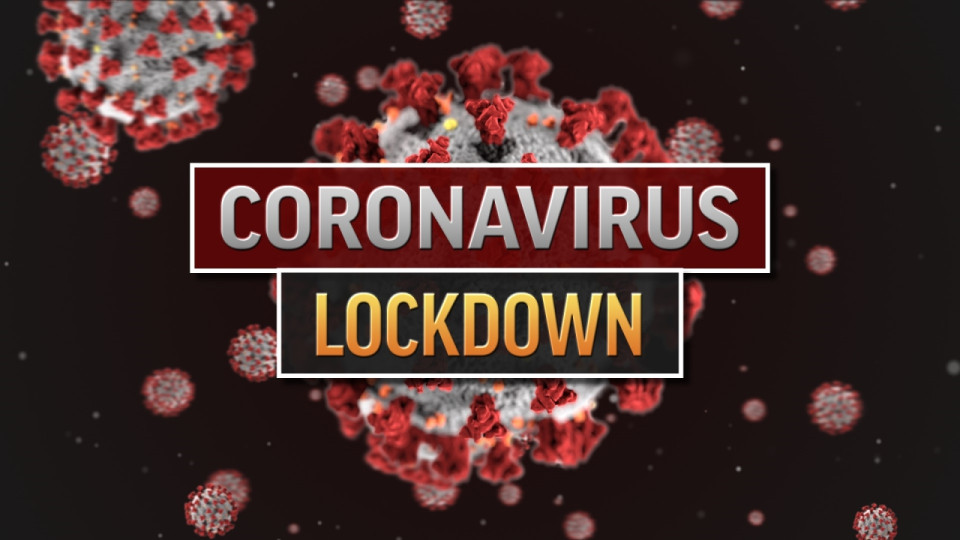
Millions of U.S. residents are now under some sort of stay-at-home order in response to the Covid 19 pandemic. There are now over 500,000 confirmed COVID-19 cases in the U.S. — more than one-quarter of the reported total cases worldwide, though the actual numbers both in the U.S. and around the world are likely much higher due to limited testing. Governors that were originally against stay-at-home orders finally succumbed last week after COVID-19 cases in their states increased rapidly.
There are still a few states that have not issued stay at home orders. Arkansas, Iowa, Nebraska, North Dakota, South Dakota, Utah and Wyoming have yet to issue any state-wide orders but they have a number of local directives suggesting residents stay indoors or have stay at home orders in place only in their harder hit counties.
For the other 95% of Americans, the states they call home slowly joined the majority to issue stay at home orders for all non-essential activities. Just as governors issued stay-at-home orders on a rolling, piecemeal basis, they have done the same on the backend, with each governor setting his or her own time frame for lifting the order. Consequently, we have end dates spanning two months, from April 15 to June 10. More than half of the states have already extended the end date of their original order and the new end date could be pushed back again as the pandemic unfolds.
Three Pacific coast states — California, Oregon and Washington — have formed an alliance called the “Western States Pact” that will reopen at the same time. They announced that they “have agreed to work together on a shared approach for reopening our economies – one that identifies clear indicators for communities to restart public life and business.” California was the first to issue its order but within 3 days, Oregon and Washington followed suit. All three states orders were issued with no set end date so their orders stay in place until further notice.
On the east coast, seven states — Connecticut, Delaware, Massachusetts, New Jersey, New York, Pennsylvania and Rhode Island — have formed the “Multi-State Council” that will also reopen at the same time. New York Governor Andrew Cuomo said the council “will come up with a framework based on science and data to gradually ease the stay at home restrictions and get our economy back up and running.” Many of these states with an end date on their original order issued extensions with new dates in May.
Two states have stay-at-home orders that are set to expire soon; Idaho (April 15) and Kansas (April 19). Both Idaho Governor Brad Little and Kansas Governor Laura Kelly have indicated that they will extend the orders. Eight states’ orders are due to expire between April 20 and April 26. Indiana, Mississippi, Alaska, District of Columbia, Missouri, Montana, Wisconsin and Colorado are fast approaching their end dates. Four governors — half of this group — have already issued one extension and several have stated they are planning another.
For the last week of April, 19 states are due to lift their stay-at-home mandates. South Carolina, New York, North Carolina, Alabama, Arizona, Florida, Georgia, Hawaii, Illinois, Louisiana, Maine, Michigan, Nevada, New Mexico, Pennsylvania, Tennessee and Texas have end dates at the end of April but again, more than half of the governors in this group have already extended the end dates for their orders once.
Nine states have stay-at-home orders that end May 4 or later. Notably, seven of them have already bumped back their end dates once, from April to May. If the trend continues, we can expect more states to be extending their mandates into May.
Read more
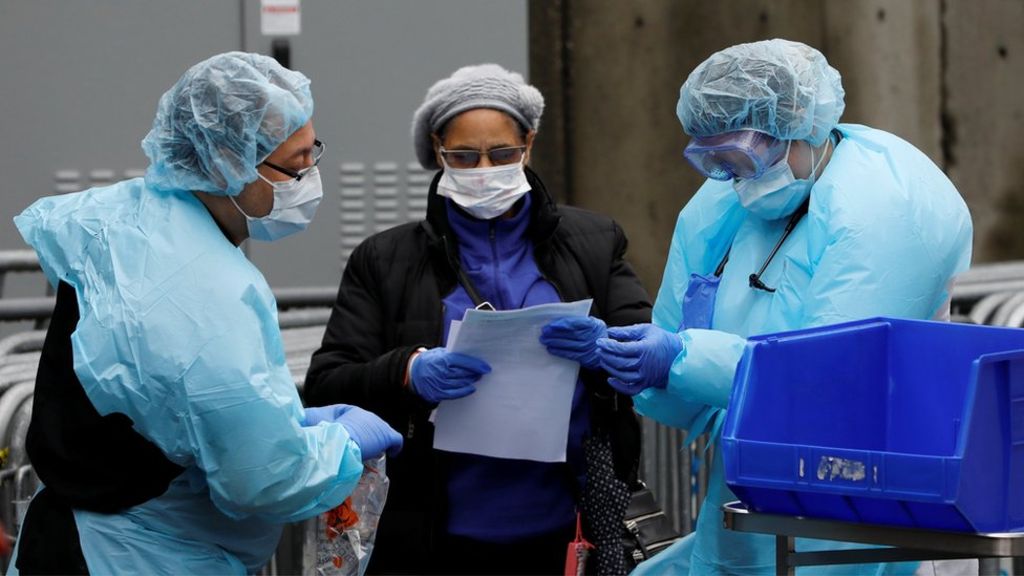
In New York City, the epicenter of the US crisis, the death toll from COVID-19 is over 4,500 and continuing to climb. There have been more than 140,000 confirmed cases of the coronavirus discovered in New York, including more than 76,876 in New York City. Thirty-five percent of the confirmed cases in the US are in the state of New York. Governor Andrew Cuomo warned state residents to expect a high death rate through July.
The Federal Emergency Management Agency is dispatching more than 250 ambulances and 85 refrigerated trucks to New York to serve as temporary morgues. In Central Park, an emergency field hospital began operations to treat spillover patients from nearby Mount Sinai Hospital. Mayor Bill de Blasio has repeatedly warned city hospitals are in dire need of millions of masks, hundreds of thousands of gowns and hundreds of ventilators, and are on the brink of running out of supplies.
Following complaints by health care workers about their inability to get tested for the coronavirus despite a colleague recently dying from COVID-19, the Mount Sinai hospital system in New York City will begin providing tests on Tuesday for any employee who shows symptoms of the disease. Mount Sinai will use PCR tests for anyone showing symptoms. They will also administer a serum antibody test to anyone who was symptomatic.
The Justice Department and Department of Health and Human Services announced that hundreds of thousands of masks and other pieces of medical equipment seized from a Brooklyn man have been distributed to medical workers on the front lines treating novel coronavirus patients in New York and New Jersey. According to the DOJ, the equipment seized and distributed includes roughly 192,000 N95 respirator masks, nearly 600,000 medical gloves, 130,000 surgical masks, procedure masks, N100 masks, surgical gowns, disinfectant towels, particulate filters, bottles of hand sanitizer and disinfectant spray. Prosecutors say 43-year-old Baruch Feldheim hoarded the supplies in order to take advantage of the COVID-19 crisis and was selling them to doctors and nurses at prices as much as 700% above market value.
Governor Cuomo said it’s unclear what will happen after New York hits its peak. Cases could begin dropping off or there could be more of a plateau effect, in which new cases and death rates remain flat. Cuomo said the falling rate of infection will not be met with a slackening of social-distancing measures. Schools and nonessential business will remain closed at least until April 29 and there will be higher fines for people violating social-distancing rules. The maximum fine is now $1,000.
Read more












